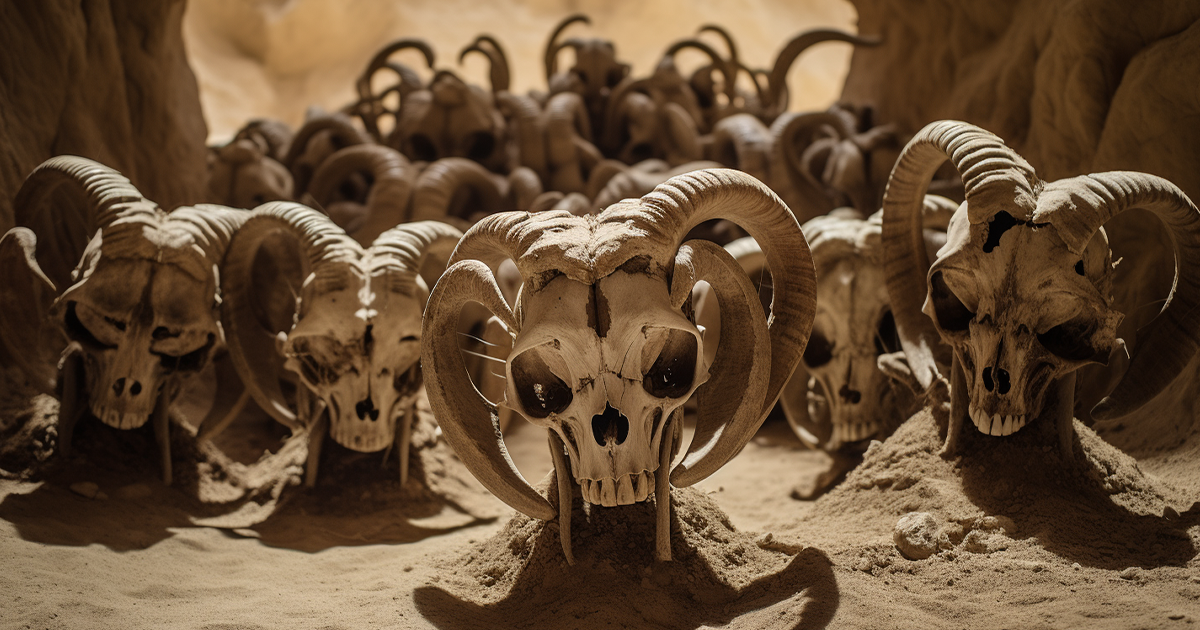In the heart of ancient Egypt, beneath the golden sands of time, lies a hidden world filled with enigmatic secrets and puzzling discoveries. Aidas, a sprawling Temple compound dating back over 5500 years, has always been a place of fascination for archaeologists and history enthusiasts alike. However, it wasn’t until 2023 that a team from New York University made an astonishing discovery that would baffle the world.
Amidst the ancient ruins of Aidas, the archaeologists delicately brushed away the sand to reveal an unexpected treasure – mummified ram skulls. What makes this discovery even more intriguing is that there were not just a few, but a staggering 2,000 of these ram skulls, meticulously stacked beside each other. These were not mere remnants from a butcher’s shop; they were revered as sacred objects.
But why would anyone go through the trouble of mummifying and burying 2,000 ram skulls together? The answer may lie in the time of Pharaoh Ramses II, also known as Ramses the Great. He reigned during the construction of the Aidas temple complex, and it is believed that these ram skulls were placed in the storeroom as an act of continued reverence, even a millennium after his passing.

However, this astonishing revelation raises another perplexing question – what happened to the rest of the Rams? Unlike other mummified animals in ancient Egypt, only the skulls of these Rams were preserved, intentionally leaving the bodies a mystery.
Interestingly, the mysteries of Aidas are not isolated incidents in Egypt’s archaeological history. Over a century and a half ago, French archaeologist AUST Marette uncovered an equally baffling collection of bodies, but this time, they were complete ones.
Marette’s expedition led him to Sakara, a place described in local folklore as the “monsters’ cage.” Located just ten miles south of the Great Pyramids of Giza, this area held a unique reputation among the local Bedouin tribes. They believed it to be a burial ground unlike any other.
As Marette explored the site, he stumbled upon a series of rooms containing massive sarcophagi. There were 24 of them, each measuring an impressive 12 feet by 6 feet by 6 feet, with lids weighing a staggering 40,000 pounds. The enormity of these coffins begged the question: what were they meant to contain, and what were they guarding against?
The answer to this puzzle lies in the sacred Apis bulls. These 1300-pound giants were revered as mediators between the individual and the Gods. They played a pivotal role in elaborate religious rituals dating back to 3000 BCE. Each sarcophagus bore inscriptions in ancient Egyptian hieroglyphs, indicating that these were the resting places of the Apis bulls. Hence, the locals’ belief in the “monsters’ cage.”
However, not all was at peace within these giant coffins. Marette stumbled upon one sarcophagus that had been broken into. Was it the monsters breaking out, or did someone dare to steal what lay inside? The answer to this question remains as elusive as the many other mysteries of Egypt.
In the world of archaeology, one mystery often leads to another, creating an intricate tapestry of unanswered questions. The wonders of Aidas and the “monsters’ cage” of Sakara remind us that the sands of Egypt conceal not only the grandeur of ancient civilizations but also the enigmatic secrets that continue to captivate our imaginations. As we delve deeper into the past, we must accept that some mysteries may never be fully unraveled.

19 thoughts on “The Mysteries of Aidas: 2,000 Mummified Skulls and the Monster Cages of Egypt”
Comments are closed.